The Iraq flag is the national emblem of a country with a colorful past and a proud present. It embodies more than simply the country’s boundaries. Beyond its remarkable appearance, the flag of Iraq is a mesmerizing representation of the country’s turbulent past, unyielding resiliency, and aspirations for the future.
In this article, we’ll delve deep into the history of the Iraq flag and interpret its symbolic significance.
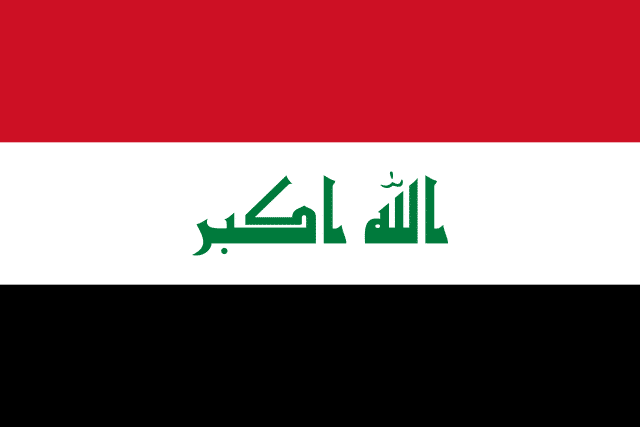
Geography & Demography of Iraq
The symbolism of the Iraq flag is significantly related to the geography and history of the country. Iraq is tucked away in the center of the Middle East. It’s located in Southwest Asia and borders Turkey, Iran, Kuwait, Saudi Arabia, Jordan, and Syria, in addition to several other nations. A crossroads of civilizations throughout history, its strategic location has shaped its terrain, population, and cultural legacy.
Iraq is located in the Eastern European Time Zone (EET), which is equivalent to UTC+3. Keep in mind that the time in Iraq may occasionally switch to Eastern European Summer Time (EEST).
The country has a diverse geography that includes enormous deserts, lush plains, and rocky mountain ranges. Ancient civilizations like Mesopotamia were fostered by the Tigris and Euphrates rivers, which are renowned as the “cradle of civilization,” since they run across the nation. Iraq’s agricultural environment has been influenced by these rivers, which also sustain populations by providing fertile space for cultivation.
Iraq’s population is made up of a variety of different ethnic and religious groupings. The majority of people are Arabs, who are followed in number by Kurds, Turkmen, Assyrians, and other ethnic groups. The majority of Iraqis identify as Muslims, mostly Sunni and Shia, and Islam is the country’s official religion. The country’s cultural fabric, which includes a variety of traditions, customs, dialects, and cuisines intertwined among its regions, reflects this religious diversity.
Periods of unrest, including wars and conflicts as well as governmental transformations, have characterized Iraq’s modern history. It is crucial to keep in mind that Iraq has its own set of cultural norms and regulations as the nation rebuilds and progresses.
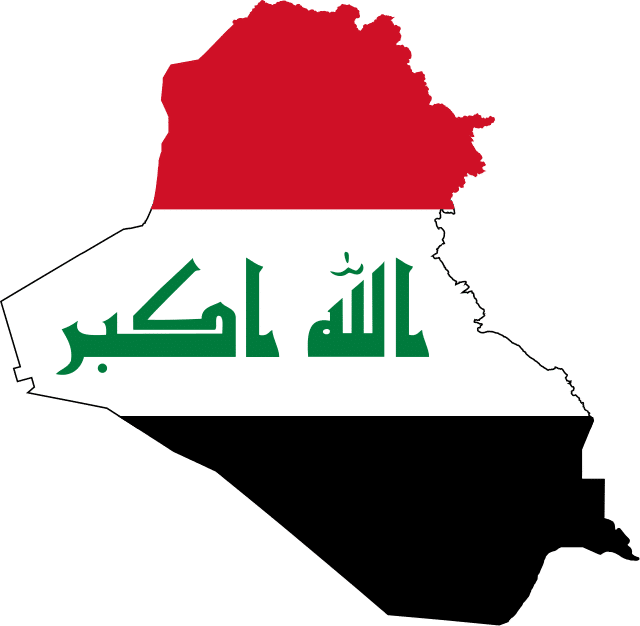
Design & Symbolism of Iraq Flag
The Iraq flag is made up of three horizontal bars of equal width that are arranged in a tricolor pattern. The bands are red, white, and black from top to bottom.
The crimson hue of the top band represents the bravery and sacrifice of all the warriors who have served Iraq over its turbulent history. It serves as a symbol of the country’s perseverance in the face of hardship. The center band, which is pure white, stands for the different ethnic and religious groups that make up Iraqi culture. It displays the desire for harmony and peace.
The bottom band, which is boldly black, represents Iraq’s victory against oppression and its past terrible times. It represents the willpower and fortitude of the Iraqi people to overcome obstacles and create a better future. The Abbasid Caliphate, which had its capital in Baghdad and is recognized as an important period in Iraq’s history, is also honored by the color black.
A vertical script in stylized Arabic calligraphy is inscribed in the middle of the white strip. Its letters are from the Arabic phrase “Allahu Akbar,” which means “God is the Greatest.” This inscription has profound religious importance since it symbolizes Islam, the predominant religion in Iraq, and the spiritual ethos that unifies its citizens.
The width and length of the Iraq flag are divided by three in a ratio of 2:3. Ordinarily, the flag’s proportions are 2 meters wide and 3 meters long. The flag comes in a variety of sizes, with smaller versions used for ceremonial occasions and bigger ones displayed in public places.
History of the Iraq Flag
The intriguing narrative of the evolution of the Iraq flag spans decades of unrest, several different governments, and the tenacity of the Iraqi people. Although the flag was initially shown in 1963, its development throughout time reflects the complicated historical events that have created Iraq’s history.
First Iraq Flag
The flag’s initial layout had three equal-width horizontal stripes: red at the top, white in the center, and black at the bottom. The Arab Liberation Flag, a symbol employed during the Arab nationalism struggle in the middle of the 20th century, served as the model for this tricolor design. A group of Iraqi nationalists, led by the poet Safi al-Din al-Safadi, developed the flag’s design.
Flag of the United Arab Republic
The history of the flag, nevertheless, was anything but steady. A new flag was adopted when the government was overthrown in a military coup in 1963. In order to symbolize the unification of Iraq, Egypt, and Syria, which together formed the transient United Arab Republic, the new flag added three green stars to the white stripe in the middle of the flag’s tricolor pattern. This modification mirrored the then-current political coalitions in Iraq.
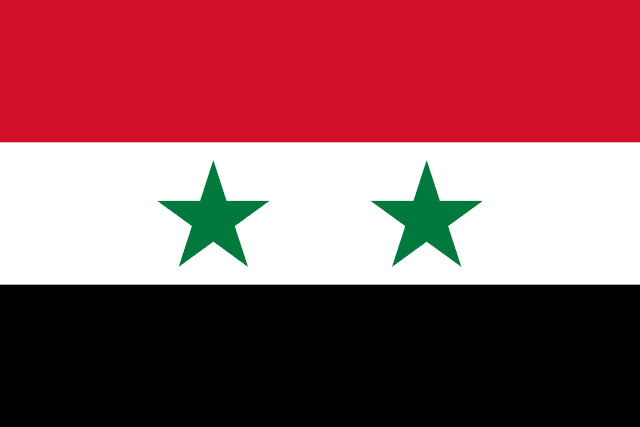
Iraq Flag During the Revolution
Following the Gulf War and the fall of the Ba’athist government in 1991, a nationwide revolt known as the Iraqi Revolution swept the nation. During this time, a modified version of the tricolor flag with Arabic text in Saddam Hussein‘s handwriting in green put in the middle of the white stripe appeared. It said, “God is Great, Saddam is the Leader.” This modification reflected the regime’s focus on the personality cult around Saddam Hussein.
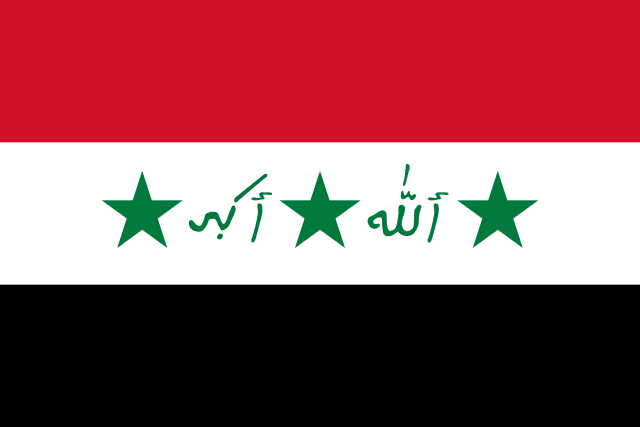
A New Flag for Hopes of Democracy
However, a new era for Iraq started with the 2003 US-led war and the overthrow of Saddam Hussein’s government. The original 1963 design of the flag was reinstated in place of the altered banner bearing Saddam Hussein’s inscription. The three-color flag came to stand for Iraq’s new beginning and the country’s hopes for democracy and unity.
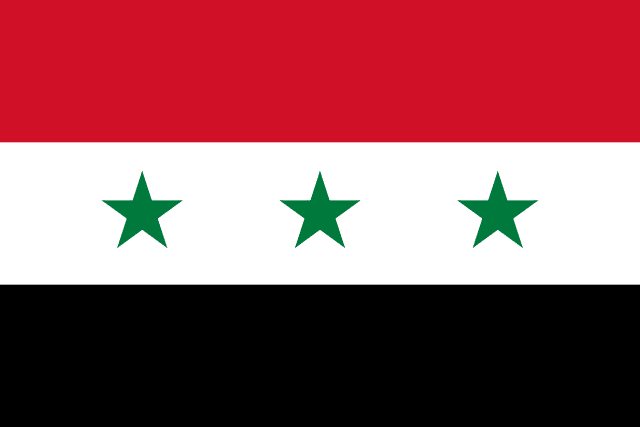
Text Alteration In 2008
In 2008, the flag’s text underwent a significant alteration. The white stripe’s middle has an altered Arabic lettering that reads “Allahu Akbar,” which translates to “God is the Greatest.” The emphasis on Iraq’s religious and cultural legacy, which brought together the country’s heterogeneous population under a single spiritual identity, was reflected in this development.
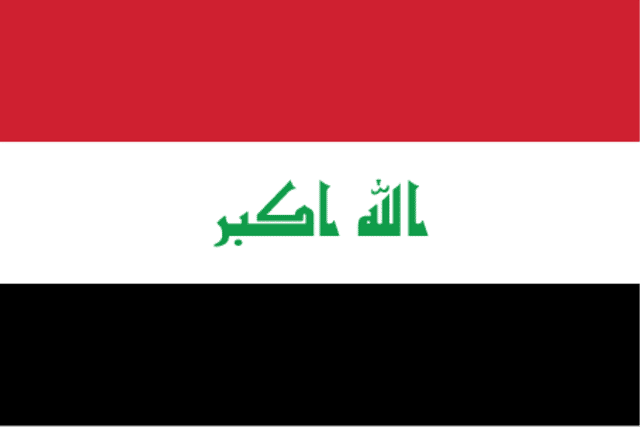
Iraq Flag Protocol
An important part of honoring and respecting the national anthem is following the proper procedures for flying and handling the Iraq flag. Respecting flag protocol makes sure that the flag receives the deference and respect it merits.
- The Iraq flag needs to be flown high and preferably on a flagpole. It must always be placed higher than any other flags in the area. If more than one flag is flown, the Iraq flag should be positioned in the middle or to the right when looking at the other flags.
- The flag should be ceremoniously raised quickly and lowered carefully. It should never come into contact with the ground or anything below it.
- The flag may fly at half-mast during periods of national sadness or commemoration. To do this, people raise the flag to its highest point before lowering it to rest halfway up and halfway down the flagpole.
- The flag should be carried respectfully and high while part of a parade. It should never be dropped or dipped as a greeting.
- The flag should be carefully and neatly folded. The flag should be folded into a triangular shape with the colors and lettering clearly visible.
- If the flag is flown at night, it must be properly illuminated to stay visible.
Iraqi Coat of Arms
The political and historical events of the nation are strongly related to the history of the Iraqi coat of arms. When Iraq gained independence in 1932, the country’s first coat of arms was chosen. It depicted a golden eagle with wings spread wide, signifying strength, sovereignty, and freedom. The Arabic word “Republic of Iraq” was written on a scroll that the eagle was holding in its beak.
However, throughout time, there were some notable alterations. The monarchy was overthrown in 1959 as a result of a military coup, and a new coat of arms was adopted. An eagle holding a shield with an image of the map of Iraq while holding its wings half closed was the subject of this artwork. The national flag’s colors were used to embellish the shield, signifying nationalism and solidarity.
Two palm fronds serve as the shield’s supports, representing peace and wealth. A rising golden sun can be seen above the shield, signifying a fresh day and optimism for Iraq’s future. The evolution of the Iraqi coat of arms over time reflects the country’s political changes and goals. Every change to its design represented a new period and national direction. The coat of arms still serves as a symbol of Iraq’s rich history, tenacity, and people as a whole today.
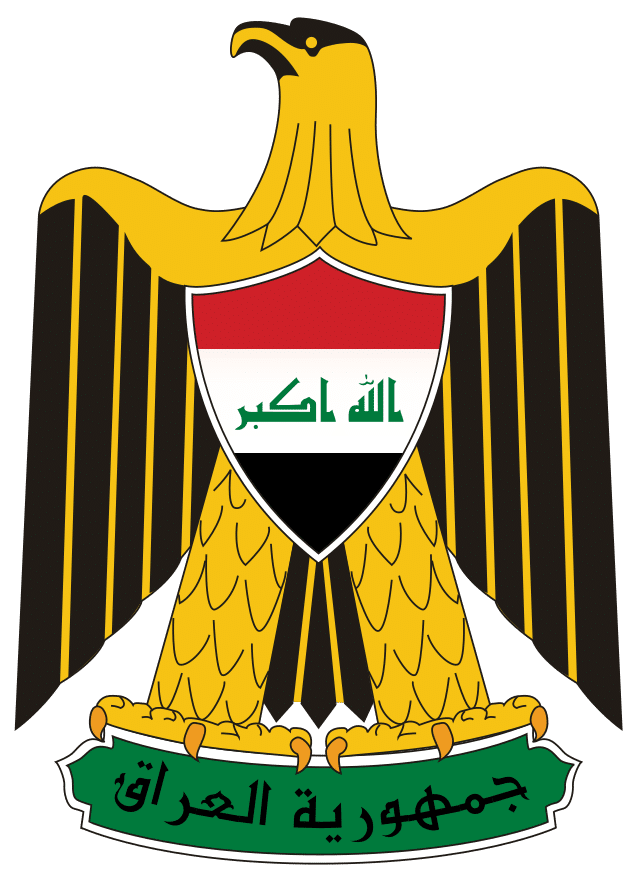
Bottom Line
The Iraq flag has seen the rise and fall of empires, fights for independence, and the quest for unification over the years. It is a reminder of innumerable people who have battled, given their lives, and persisted in their quest for a brighter future. For future generations, it serves as a symbol of togetherness, a source of hope, and an inspiration.